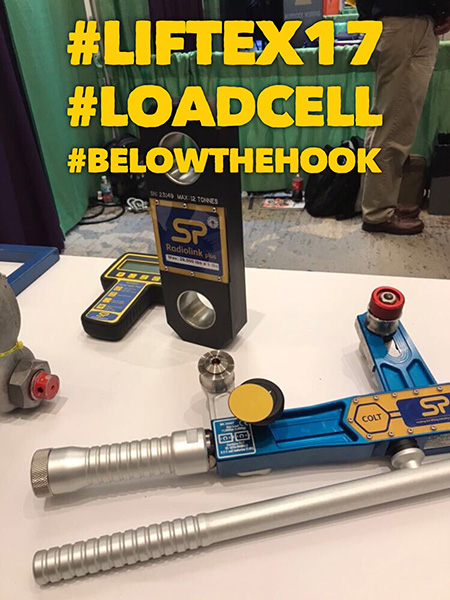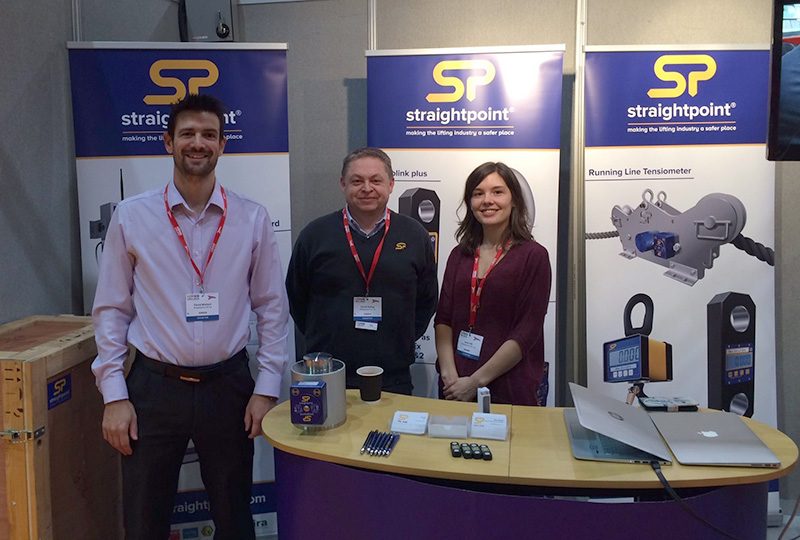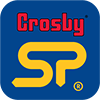In his latest blog, Mr. Loadlink sets LiftEx 2017 a challenge and shares a slice of Halloween pumpkin pie.
It’s Halloween morning at the time of writing here in the UK. This evening, children (and some adults) across the land will be dressing up in all manner of costumes to call upon friends, family and neighbours to yell, “Trick or treat?” as they answer their front doors.
It’s innocent fun, yet not everyone participates. Some decorate their houses with carved pumpkins, cobwebs and creepy-crawlies, and equip themselves with treats to give out to their spooky guests. Others, meanwhile, turn off the lights and barricade themselves into a back room, waiting for the frightening frivolities to end.
It’s much the same with social media, particularly in the lifting equipment industry, as proved by the ongoing trade show season. There are companies, like Straightpoint (SP), that embrace social platforms, especially when it comes to networking before, during and after trade events at related hashtags. On the other hand, there are those who hardly keep a website up to date and rely on more traditional methods to engage their target audiences.

Social media scares some people more than Halloween
Interestingly, when hashtags came knocking for Twitter, it was widely reported that it said, “Trick”, in response. Former Google employee Chris Messina posted on 23 August 2007:
‘how do you feel about using # (pound) for groups. As in #barcamp [msg]?’
Twitter apparently slammed the door shut. Thus, despite millions of hashtags now being used every hour across Twitter and other social media, I don’t think the lifting industry, indeed any niche sector, should hold its head in shame. It can be scary stuff. I just suggest they might be missing a trick. To me, hashtags are a ripe, juicy, succulent, forever giving treat. Kind of like pumpkins, only tastier.
One dictionary definition of the word ‘hash’ resonates with me: ‘come to agreement on something after lengthy and vigorous discussion.’ Add ‘tag’ on the end and a picture starts to emerge of what hashtags are; they’re effectively content labels. People make statements about a topic, product area, trade show or sports team, for example, and include a hashtag, which becomes clickable and part of a library of Tweets or posts alongside others who’ve done the same.
Taming AWRF
SP has participated in a number of shows over the past couple of months, all provoking varying levels of social media uptake.
Last week, we were at the latest Associated Wire Rope Fabricators (AWRF) meeting and charmingly named PIE (or Product Information Exhibition), which was a case in point. I didn’t attend the event in person this time but actually that meant I was even better placed to assess the social media participation. The good, bad and monstrously ugly were there for all to see. Some joined us in posting quality content to the #AWRFpie17 hashtag, others less so and the majority of participants chose to abstain.
I have a huge amount of respect for AWRF and their 18-monthly product fair is outstanding. That said, I’d like to have seen them do a bit more to promote the #AWRFpie17 hashtag in the months leading up to the event so people could start using it. Greater prominence would also have meant folks would have been less inclined to make up their own tags—#AWRF and #AWRFpie2017 were just two I saw—because the official one would have been more deeply engrained.
Many of our fellow exhibitors could have also done more to post quality content before, during and after the show. Imagine if every vendor had posted even one Tweet or one post to every social media platform they operate with an educational message related to the event or their equipment. Put oneself in the position of an attendee and consider how valuable that #AWRFpie17 hashtag would have become. They could have found out about all the product suppliers relevant to their work and probably discovered a solution or thought leader or two they didn’t know existed.
I counted about 50 relevant Tweets at #AWRFpie17 but, as an industry, that’s not really much to shout (or Tweet) about. SP and like-minded businesses that are well versed in harnessing the power of hashtags largely posted that content. Witches’ hats off to all of them. The comments that really stood out from afar were the ones that went deeper than merely sharing a photo of an exhibit or reference to a product. The selfies were great and I thought Tweets that promoted other related hashtags added tremendous value. We included #loadcell and #belowthehook in posts, for example, allowing the curious to explore a deeper drill into our marketplace.

Hashtags bring together people with shared interests
Lifting LiftEx
AWRF and the organisers of next month’s (November) LiftEx trade show, the Lifting Equipment Engineers Association (LEEA), have much in common. However, I’m backing the latter to generate more content at its event hashtag, #LiftEx17. The marketing team have done a good job of promoting the tag; it’s been prominent on the website and literature for months. Many, ourselves included, are already posting content across a variety of social platforms.
The LEEA community can take it as a challenge if they want, but I think #LiftEx17 posts will quadruple those at #AWRFpie17, even during the two days of the Telford show alone.
I’d encourage everyone who’s exhibiting or attending to join the online network. This blog isn’t about which platform is more relevant or effective so whether it’s a fun post for Facebook, a photo for Instagram, a thought-provoking Tweet, or business-themed comment on LinkedIn, share content and include #LiftEx17. While it takes time and an element of know-how to get mileage out of social media, it’s essentially free and worth the effort.
Yes, the lifting sector is traditional and mechanical but hashtags are a place for niche geeks like us to hang out. Twitter wasn’t wrong to point that out to Messina but it did initially misread the opportunity. We’re proud of the content we’ve posted to #AWRFpie17, #LiftEx17, #loadcell, #belowthehook, #oilandgas, and many more.
“See you at Stand B5 for a selfie!”
First, we’ll be posting to social media from this week’s Speedy Expo and KHL’s World Crane and Transport Summit, which takes place 7-8 November in Amsterdam.

David-Mullard-and-Jessi-Boskovic,-here-with-me-at-LiftEx-2016, will-once-again-make-up-the-SP-team-at-this-year’s-show
The Pumpkin Plan
I’m an avid reader of business-themed literature and it’s a fitting time of year to have recently finished The Pumpkin Plan, by Mike Michalowicz. The book explores the theory that as entrepreneurs, there is nothing harder than getting rid of ideas, businesses, or customers that don’t work. It calls on the theory that pumpkin farmers are obsessed with nurturing their healthy, fat, prize-winning assets, rather than wasting time and effort feeding and watering a bed of small vegetables that aren’t going to ever be bigger than one’s hand—and will leave an unpleasant taste in the mouth.
(I’ve also just read They Ask You Answer, by Marcus Sheridan, about a revolutionary approach to inbound sales, content marketing and today’s digital consumer. It served as great inspiration too but a Halloween reference was less forthcoming [the best I had was that it was spookily good] hence the lead on The Pumpkin Plan.)
As is the case with any business text I read, I made frequent references to my own firm and effectively challenged the author to apply his theories and sciences to a manufacturer of load cells. It led me to thinking about our Melbourne, Australia-based dealer Hoisting Equipment Specialist (Vic) Pty Ltd (HES). If Dean Nelson’s company were a pumpkin, there’d be comparisons with James and the Giant Peach. It’d win prizes in the county fair and would feature on the front cover of the local newspaper.
As we challenge our existing dealer network (there are many prize pumpkins among them) and look to introduce new partners in certain markets, it’s tempting to look at the shape, size and type of success stories like HES. However, what has become increasingly apparent, and was further stressed by Michalowicz and Sheridan, is the DNA profile we need to seek is based more on a business’s people and less on its characteristics.
Home away from home
HES hasn’t soared into our top 10 global distributors in just 11 months because of bricks, mortar, the marketplace and nutrients in the soil; it’s on the way to status among our Big 5 because of Dean and his team. The office couldn’t be further from SP’s Havant headquarters, but walking into HES feels like being at home; there is a positive vibe, people enjoy coming to work, they use hashtags(!), and the company’s sales team and leaders bang the drum with passion. They’re an SP clone; we’re like two pumpkins in a patch.
That’s not to say every partner has to be identical to us—that would be too Stepford Wives—but there are hallmarks to look for. Rigmarine, Van Gool and others share these commonalities. When the phone rings and it’s Mike Duncan (Rigmarine) or Pieter van Duijn (Van Gool), we don’t look around to see who draws the short straw, we all rush to the handset to exchange pleasantries and hear the latest positivity. We follow the fortunes of our key partners’ sports teams and ask how their kids got on in their latest college matches.
With all that in mind, we recently updated our call for distributors on the SP website – goo.gl/YqEvfY – as we look to make some strategic appointments early in 2018. It’s arguable that, as the profile we’re looking for isn’t so easily researched, this quest is harder than it once was. There’s some truth in that but once we get such partners on board, the rewards and longevity make it worthwhile. And we’re getting good at reading the signals. While it’s important to observe formalities at the outset, when a new partner starts to include friendly emojis in messages, we get a better feeling than if all correspondence ends with a formal email signature.

It’s a good sign when a new distributor puts-an emoji in an email
Thank you for reading 🙂
Happy Halloween 😉
Mr. Loadlink
